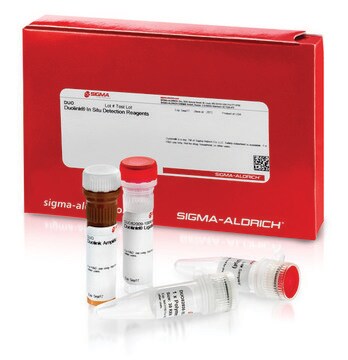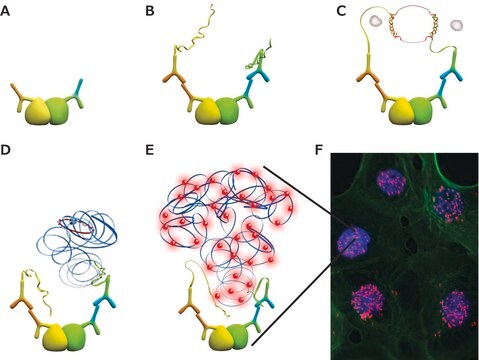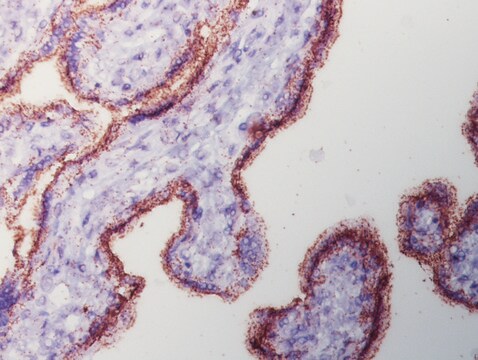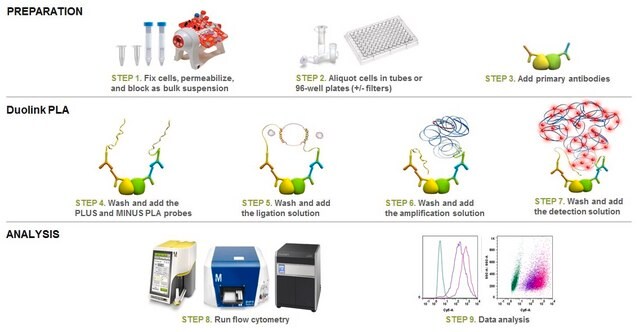DUO92004
Sonde PLA® in situ DuolinkDuolink® anti-souris MINUS
Affinity purified Donkey anti-Mouse IgG (H+L)
Synonyme(s) :
in situ Proximity Ligation Assay reagent, Protein Protein Interaction Assay reagent
About This Item
Produits recommandés
Source biologique
donkey (polyclonal)
Niveau de qualité
Forme d'anticorps
affinity purified immunoglobulin (secondary antibody)
Type de produit anticorps
primary antibodies
Gamme de produits
Duolink®
Espèces réactives
mouse
Technique(s)
immunofluorescence: suitable
proximity ligation assay: suitable
Adéquation
suitable for brightfield
suitable for fluorescence
Conditions d'expédition
wet ice
Température de stockage
2-8°C
Catégories apparentées
Description générale
Application
Selon les réactifs de détection employés, ce produit peut être utilisé pour le protocole à fluorescence in situ Duolink® ou le protocole à fond clair in situ Duolink®.
Pour réaliser une expérience PLA in situ Duolink® complète, vous avez besoin de deux anticorps primaires (validés par PLA, IHC, ICC ou IF) reconnaissant deux épitopes cibles. Il vous faut également une paire de sondes PLA de deux espèces différentes (une sonde positive et une sonde négative), des réactifs de détection, des tampons de lavage et du milieu de montage. Notez que les anticorps primaires doivent provenir de la même espèce que les sondes PLA Duolink®. L'analyse s'effectue sur un équipement de test d'immunofluorescence standard. De la peroxydase de raifort (HRP) est également disponible pour la méthode de détection en fond clair.
La sonde PLA anti-souris réagit avec l'ensemble de la molécule d'IgG de souris ainsi qu'avec les chaînes légères d'autres immunoglobulines de souris. Cette sonde peut réagir de façon croisée avec les anticorps de rat, mais elle présente une très faible réactivité croisée avec les protéines sériques humaines, de bovin, de poulet, de chèvre, de cobaye, de hamster doré, de cheval, de lapin et de mouton. Ce produit doit être utilisé avec une sonde positive d'une espèce différente. Consultez notre guide de sélection de produits pour obtenir de plus amples informations.
Note d'application
Cette application nécessite deux anticorps primaires produits par des espèces différentes. Testez vos anticorps primaires (de type IgG, monoclonaux ou polyclonaux) avec un test standard d'immunofluorescence (IF), d'immunohistochimie (IHC) ou d'immunocytochimie (ICC) pour déterminer les conditions optimales de fixation, de blocage et de titrage. Les réactifs de PLA in situ Duolink® peuvent être utilisés sur des cellules fixées, des cellules centrifugées sur un appareil Cytospin, des cellules cultivées sur une lame, fixées au formol et incluses en paraffine (FFPE), ou du tissu (frais ou congelé). Aucun nombre minimal de cellules n'est requis.
Laissez-nous faire le travail pour vous et découvrez notre Programme de services sur mesure pour accélérer vos projets Duolink®.
Consulter la liste complète des produits Duolink®.
Caractéristiques et avantages
- Aucune surexpression ou manipulation génétique nécessaire
- Grande spécificité (moins de faux positifs)
- Sensibilité à une seule molécule du fait de l′amplification par cercle roulant
- Quantification relative possible
- Aucun équipement spécial requis
- Plus rapide et plus simple que la technique FRET
- Exactitude accrue par rapport à co-IP
- Résultats prêts à être publiés
Composants
- 5x Sonde PLA MINUS anti-souris - anticorps secondaire d′âne anti-souris conjugué à un oligonucléotide MINUS
- 1x Solution de blocage - réactif permettant de bloquer l′échantillon
- 1x Diluant pour anticorps - pour la dilution des sondes PLA et des anticorps primaires
Notes préparatoires
Autres remarques
Informations légales
Vous ne trouvez pas le bon produit ?
Essayez notre Outil de sélection de produits.
Mention d'avertissement
Warning
Mentions de danger
Conseils de prudence
Classification des risques
Aquatic Chronic 2 - Skin Sens. 1
Code de la classe de stockage
12 - Non Combustible Liquids
Point d'éclair (°F)
Not applicable
Point d'éclair (°C)
Not applicable
Certificats d'analyse (COA)
Recherchez un Certificats d'analyse (COA) en saisissant le numéro de lot du produit. Les numéros de lot figurent sur l'étiquette du produit après les mots "Lot" ou "Batch".
Déjà en possession de ce produit ?
Retrouvez la documentation relative aux produits que vous avez récemment achetés dans la Bibliothèque de documents.
Les clients ont également consulté
Articles
Proteins are complex biological molecules essential for cellular structure and functions. The majority of proteins commonly interact with various molecules, including other proteins, in order to exert their functions.
Find Duolink references based on the type of method used, post translational modification detected, and research focus.
Things to consider for preparation, setup and execution of the Duolink® assay protocol
Support information including tips and tricks, frequently asked questions, and basic troubleshooting.
Protocoles
This protocol describes the use of Duolink® PLA reagents for the brightfield detection, visualization, and quantification of individual proteins, protein modifications, and protein interactions in tissue and cell samples.
Protocol for use of Duolink® PLA reagents for the detection of individual proteins, protein modifications, and protein-protein interactions within cell populations by flow cytometry.
Contenu apparenté
Applications to detect, quantify and visualize protein-protein interactions, post-translational modifications and low expression protein detection using proximity ligation assay
Notre équipe de scientifiques dispose d'une expérience dans tous les secteurs de la recherche, notamment en sciences de la vie, science des matériaux, synthèse chimique, chromatographie, analyse et dans de nombreux autres domaines..
Contacter notre Service technique












